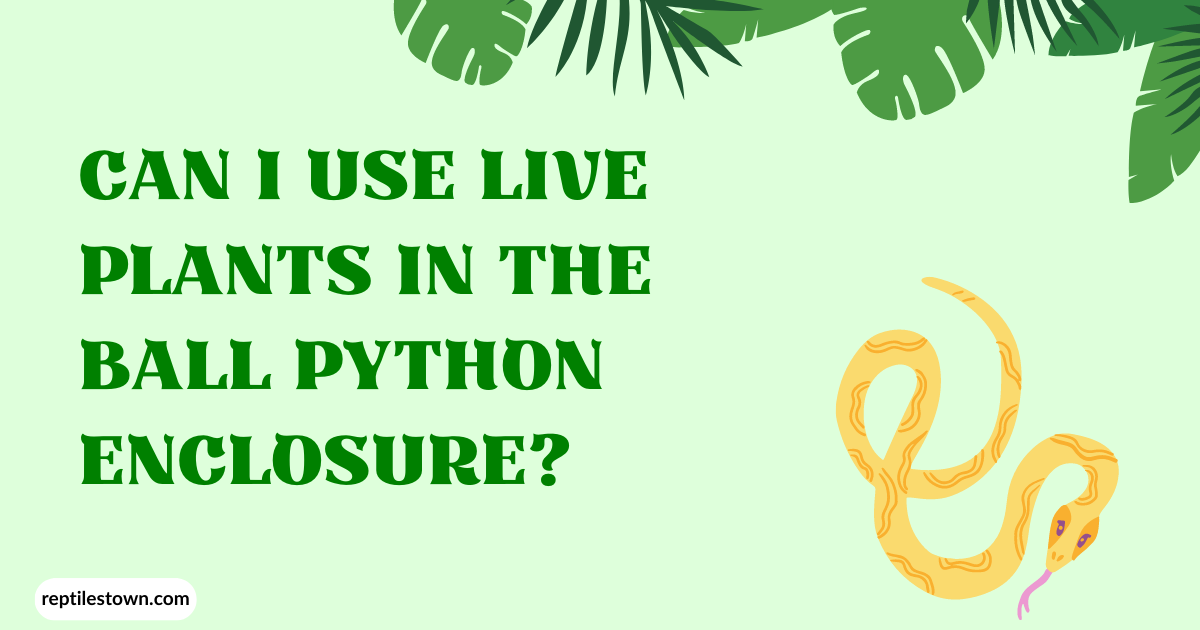If you’re a reptile enthusiast and a ball python owner, you might have wondered whether live plants can be used in your snake’s enclosure.
Providing a natural habitat for your pet can have numerous benefits, including reducing stress and promoting overall well-being.
In this comprehensive guide, we will explore the concept of using live plants in the ball python enclosure, the benefits they offer, how to set up a safe environment, and much more.
Let’s dive in and create an ideal living space for your scaly companion!
Can I Use Live Plants in the Ball Python Enclosure?
Ball pythons, native to Africa, thrive in a semi-arid environment with lush vegetation and hiding spots. It prompts snake keepers to consider adding live plants to their enclosures.
The answer is YES! Live plants can be a valuable addition to the ball python enclosure, enhancing the habitat and providing a more enriching experience for your ball python.
The Benefits of Live Plants in the Ball Python Enclosure
![]() Aesthetic Appeal: Live plants add a touch of natural beauty to the enclosure, creating a visually pleasing environment for both you and your snake.
Aesthetic Appeal: Live plants add a touch of natural beauty to the enclosure, creating a visually pleasing environment for both you and your snake.
![]() Improved Air Quality: Live plants act as natural air purifiers, helping to reduce pollutants and maintain better air quality inside the enclosure.
Improved Air Quality: Live plants act as natural air purifiers, helping to reduce pollutants and maintain better air quality inside the enclosure.
![]() Psychological Enrichment: A lush and natural environment can help reduce stress and anxiety in ball pythons, promoting overall well-being.
Psychological Enrichment: A lush and natural environment can help reduce stress and anxiety in ball pythons, promoting overall well-being.
![]() Humidity Regulation: Live plants maintain optimal humidity levels in the enclosure, which is essential for ball pythons’ health.
Humidity Regulation: Live plants maintain optimal humidity levels in the enclosure, which is essential for ball pythons’ health.
![]() Behavioral Stimulation: The presence of live plants encourages exploration and provides opportunities for climbing, hiding, and basking, promoting natural behaviors.
Behavioral Stimulation: The presence of live plants encourages exploration and provides opportunities for climbing, hiding, and basking, promoting natural behaviors.
How to Select Suitable Live Plants?
Choosing the right live plants for your ball python enclosure is crucial to ensure a safe and thriving habitat. Consider the following factors when making your selection:
![]() Non-Toxic Plants: Opt for non-toxic plants to ensure your snake’s safety. Some toxic plants can harm ball pythons.
Non-Toxic Plants: Opt for non-toxic plants to ensure your snake’s safety. Some toxic plants can harm ball pythons.
![]() Low-Maintenance: Select plants that are easy to care for and can thrive in the enclosure’s conditions.
Low-Maintenance: Select plants that are easy to care for and can thrive in the enclosure’s conditions.
![]() Climbing Opportunities: Choose plants that offer climbing opportunities, as ball pythons are excellent climbers.
Climbing Opportunities: Choose plants that offer climbing opportunities, as ball pythons are excellent climbers.
![]() Hiding Spots: Incorporate plants that provide hiding spots to reduce stress and secure your snake.
Hiding Spots: Incorporate plants that provide hiding spots to reduce stress and secure your snake.
Setting Up the Enclosure with Live Plants
Here’s a step-by-step guide on how to set up your ball python’s enclosure with live plants:
![]() Research and Planning: Research the specific care needs of the live plants you wish to include. Plan the layout of the enclosure to maximize the plants’ benefits.
Research and Planning: Research the specific care needs of the live plants you wish to include. Plan the layout of the enclosure to maximize the plants’ benefits.
![]() Choose Appropriate Containers: Use appropriate containers for the live plants, ensuring they fit well within the enclosure and won’t be easily uprooted.
Choose Appropriate Containers: Use appropriate containers for the live plants, ensuring they fit well within the enclosure and won’t be easily uprooted.
![]() Substrate and Drainage: Add suitable substrate to the plant containers and ensure proper drainage to prevent waterlogging.
Substrate and Drainage: Add suitable substrate to the plant containers and ensure proper drainage to prevent waterlogging.
![]() Positioning: Strategically position the live plants within the enclosure to offer climbing opportunities and hiding spots.
Positioning: Strategically position the live plants within the enclosure to offer climbing opportunities and hiding spots.
![]() Lighting and Temperature: Ensure the enclosure receives appropriate lighting and maintain suitable temperatures for both the plants and your snake.
Lighting and Temperature: Ensure the enclosure receives appropriate lighting and maintain suitable temperatures for both the plants and your snake.
FAQs
Can I use any plant in the ball python enclosure?
No, it is essential to choose non-toxic plants suitable for the snake’s habitat.
Will live plants increase humidity in the enclosure?
Yes, live plants can contribute to maintaining the appropriate humidity levels for ball pythons.
How often should I water the live plants?
The watering frequency will depend on the plant’s specific care requirements and the enclosure’s humidity levels.
Can live plants improve my ball python’s overall health?
Yes, providing a natural environment with live plants can positively impact your snake’s well-being.
Conclusion
Introducing live plants into the ball python enclosure can be a rewarding experience for you and your pet. These plants add beauty and charm to the habitat and contribute to your snake’s overall well-being.
Remember to select non-toxic and low-maintenance plants that thrive in the enclosure’s conditions. Providing a natural environment with live plants will make your ball python feel at home and demonstrate your dedication as a responsible pet owner.
Related Articles:
Ball Python Not Eating: Causes and Solutions
Can a Ball Python Kill a Cat? Everything You Need To Know
How Long Can a Ball Python Go Without Water? A Detailed Guide

